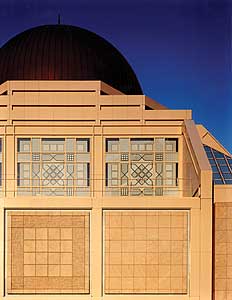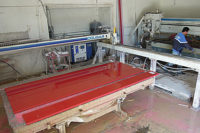
The Stony Creek Quarry in Connecticut, which has supplied granite for many historic architectural projects, has been revitalized under the ownership of Stony Creek Quarry Corp., which has brought in new equipment and quarrying strategy.
Located in the Stony Creek section of Branford, CT, the Stony Creek Quarry has supplied materials for a broad range of historic architectural projects over the years, perhaps most notably the Statue of Liberty. Two years ago, the quarry received a thorough revitalization with the introduction of new ownership and an upgraded strategy that will take it well into the 21st century.
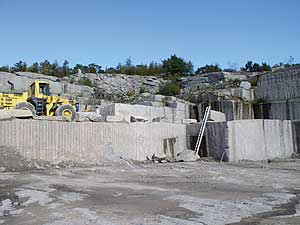
“We opened up an area of over 350,000 cubic feet, and we are thinking long-term - not just what is good right now,” explained company owner Doug Anderson. “We are also thinking about how the quarry will integrate back into the surrounding Town landscape as it continues to grow and develop in the future.”
In doing so, Anderson first dedicated the company’s efforts to revamping the quarry for consistent efficient production. “We invested a lot of time and money in getting the stone accessible,” he said. “We opened up an area in excess of 350,000 cubic feet, and are thinking long-term - not just what is good right now- but also planning on how the quarry will integrate back into the surrounding Town landscape as it continues to grow and develop in the future.”
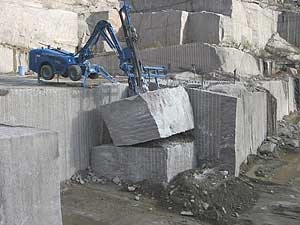
Current production stands at 4,000 cubic feet per month, but that can be expanded if needed.
The new ownership also formed a relationship with Darrell Petit, who is working to connect the quarry to the architectural community and major stone processors worldwide. Petit began working at the site in 1990, and as an international architectural sculptor, he forged relationships with a number of renowned architects - including Cesar Pelli, Kevin Roche and Diana Balmori, among others.
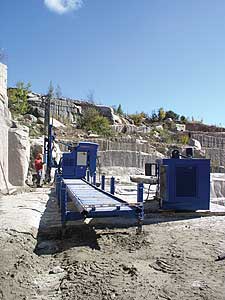
New equipment in the quarry includes drilling rigs from Perfora of Italy, supplied through Driller’s Choice of Newport, RI. Models at work in the site include the “Tempest” (shown being operated by foreman Richard Atkinson, who has been working in the quarry for 28 years).
The quarry tours may also stimulate architects to use the material in new ways. “Seeing the methods and the material in its raw state can inspire designers to do something they haven’t seen before,” Petit said. “We have one architect who wants to create a cladding system using the drill marked surfaces of the blocks. By working directly with the quarry we want to expose architects to a new perspective and expand their creative possibilities in design.
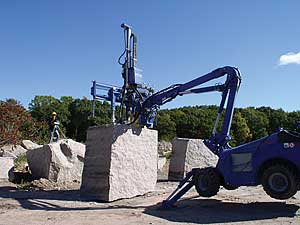
The quarry also utilizes a Perfora “Rock Buggy” drill, shown being operated by Stacy Mancini, one of the first female operators in the dimensional quarrying world.
In addition to opening up an area of the quarry that contains over 350,000 cubic feet of material, the current recovery rate is 40%, which is higher than usual. “We’ve opened up the quarry and presented benches and levels that set us up for a good five-year run,” Petit said. “We’ve cleaned it up more than I’ve seen in 15 years. The previous strategy was to go after any areas that had good stone without so much regard for the long term. We’re now using the proven Finnish Method of developing wide while quarrying into the depth of the quarry.”
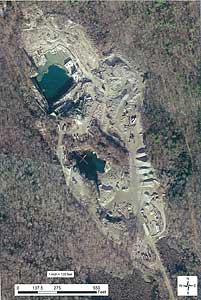
New equipment in the quarry includes drilling rigs from Perfora of Italy, supplied through Driller’s Choice of Marietta, GA, and Newport, RI. Models at work in the site include the “Rock Buggy” and the “Tempest,” and the company is now planning on adding a Perfora “Speedcut” diamond wire saw.
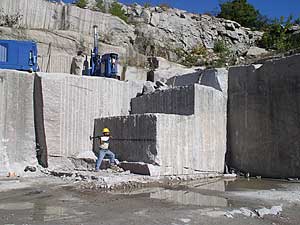
In addition to utilizing modern equipment, extraction at the Stony Creek Quarry relies on traditional methods such as manually splitting using wedges.
A total of four workers are in the quarry, with the possibility of adding more as dictated by demand. “Most of the people involved have been doing this for years,” Atkinson said. “We haven’t had much turnover. The new equipment is relatively simple to implement. The quarry layout comes with experience, but operating the new machinery isn’t too difficult.”
The quarry currently runs one shift, and it operates year round. “Other than heavy snow, the cold doesn’t really affect us,” Atkinson said. “We’re on the coast, so it is relatively mild.”
When bringing in new employees, Atkinson prefers to train new workers from scratch. “There are a lot of people who can run a loader, but it is different in a quarry,” he said. “We’re better off with someone who is green.” Of note, Atkinson was responsible for training one of the first female operators in the dimensional quarrying world, Stacy Mancini, who has been working in the Stony Creek Quarry for several years.
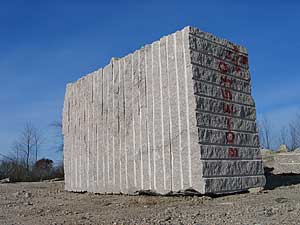
The quarry is currently producing gangsaw blocks measuring 6.5 x 10.5 feet x 4.5 feet in size.
The quarry is capable of producing gangsaw-sized blocks measuring 6.5 x 10.5 feet in size. Among the worldwide processors of these blocks, Nikolas Bagnara S.p.A. Ag of Italy is currently producing fabricated products and finished slabs of Stony Creek Classic granite for the European marketplace. Stony Creek provides blocks to the major Canadian fabricators including A. Lacroix et Fils Granit Ltee., Polycor Inc. and Granicor Inc., which are serving the North American and International marketplace as well. Block processors and fabricators in the U.S. include Granites of America of Esmond, RI, North Carolina Granite Co. of Mt. Airy, NC, and Structural Stone, LLC of North Kingstown, RI, which is the fabrication facility formerly operated by New England Stone, LLC.
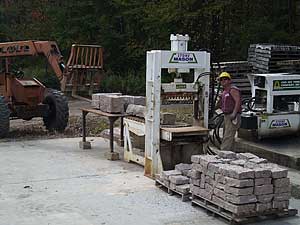
In addition to blocks, Stony Creek Quarry Corp. is also creating veneer stone from the quarry by-products, which are split using a “Stone Mason” hydraulic splitter from Cee-Jay Tool Co., Inc.
Additionally O&G Industries, based in Torrington, CT, with five showrooms throughout Connecticut is showcasing and fabricating Stony Creek Classic granite locally and has just completed a large fabrication and installation for the Quinnipiac University York Hill Campus Dormitories, designed by Centerbrook Architects and Planners, LLP. “It is important for the re-emergence of this quarry to be associated with the people and companies in the industry who respect and understand the stone and will carry the brand and tradition forward,” Petit said.
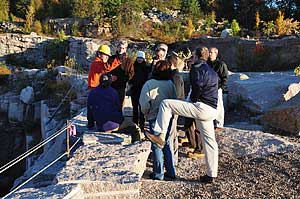
Photograph courtesy of Centerbrook Architects and Planners LLP
In order to showcase recent developments at the quarry, architectural tours at the site are regularly hosted by Darrell Petit, who has been associated with the quarry since 1990. On the day of Stone World’s visit, for example, the quarry hosted a group from Centerbrook Architects of Centerbrook Architects and Planners LLP, Connecticut.
In order to showcase recent developments at the quarry, architectural tours at the site are regularly hosted by Darrell Petit, who has been associated with the quarry since 1990. On the day of Stone World’s visit, for example, the quarry hosted a group from Centerbrook Architects of Centerbrook Architects and Planners LLP, Connecticut.
Current projects include work for the 34th Street Partnership, which is a coalition responsible for the revitalization of a large section of midtown Manhattan. “We have Stony Creek granite on nearly every corner of our 31-block Business Improvement District, including Herald and Greeley Squares,” said Matthew Coogan, Assistant Project Manager for the 34th Street Partnership/Bryant Park Corp. “And we look forward to continuing to use Stony Creek granite in the future.”
Other ongoing projects include the restoration at Jackie Robinson Park in New York City; Voorhees Hall at the New York City College of Technology, being completed by Der Scutt Architect; and continuing work at Battery Park City. It is has also produced 5,000 cubic feet of stone for the Northwest Corner Building at Columbia University in New York City, which is designed by world-renowned Spanish architect Rafael Moneo with Davis Brody Bond Aedas, LLP of New York City as executive architect. “It is exciting to see Stony Creek Classic granite in places that will have a permanent impact,” Petit said.
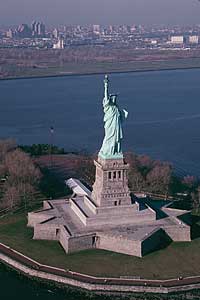
Photographs courtesy of The National Park Service - Kevin Daley
One of the most renowned uses of the material was the Stony Creek Classic granite base of the Statue of Liberty, designed by Richard Morris Hunt.
One of the most renowned uses of the material was the Stony Creek Classic granite base of the Statue of Liberty, designed by Richard Morris Hunt.
Additional Photos
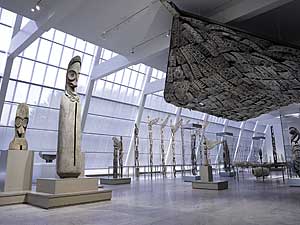
Photograph courtesy The Metropolitan Museum of Art.
The granite was also used for the floors of the Oceanic Art Gallery at The Metropolitan Museum of Art designed by Kevin Roche and John Dinkeloo and Associates.
The granite was also used for the floors of the Oceanic Art Gallery at The Metropolitan Museum of Art designed by Kevin Roche and John Dinkeloo and Associates.
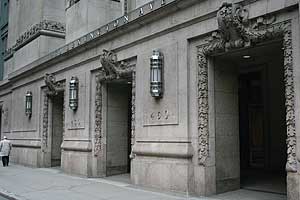
Photograph courtesy of Darrell Petit LLC
In a cladding application, Stony Creek Classic granite was used for the Post Office at Grand Central Station in New York.
In a cladding application, Stony Creek Classic granite was used for the Post Office at Grand Central Station in New York.
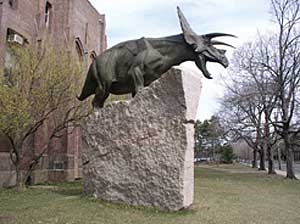
Over the years, Petit has used Stony Creek Classic granite for sculptures around the world, including a piece at Yale University’s Peabody Museum of Natural History in New Haven, CT. A 21-foot, life-sized bronze Torosaurus statue, sits atop a 95-ton base of Stony Creek Classic granite.
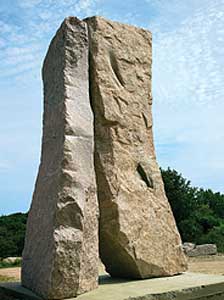
Photograph courtesy of Sean Kernan
Petit also sculpted “Kiss” in 2008, which is comprised of two 25-ton elements of Stony Creek Classic granite.
Petit also sculpted “Kiss” in 2008, which is comprised of two 25-ton elements of Stony Creek Classic granite.
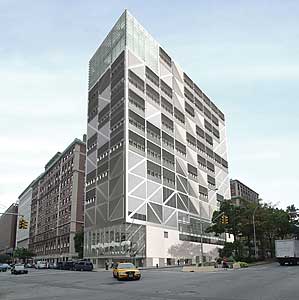
Photo courtesy of Moneo Brock Studio
For Columbia University’s Northwest Corner Building in New York, Stony Creek Classic granite was chosen to match that used in the bases of the McKim Meade and White buildings on the Morningside campus, and the groove design calibrated to show a maximum of depth and strength within the means available. The Design Architect for the project is Rafael Moneo Valles Arquitecto of Spain, while the Executive Architect is Davis Brody Bond Aedas of New York.
For Columbia University’s Northwest Corner Building in New York, Stony Creek Classic granite was chosen to match that used in the bases of the McKim Meade and White buildings on the Morningside campus, and the groove design calibrated to show a maximum of depth and strength within the means available. The Design Architect for the project is Rafael Moneo Valles Arquitecto of Spain, while the Executive Architect is Davis Brody Bond Aedas of New York.
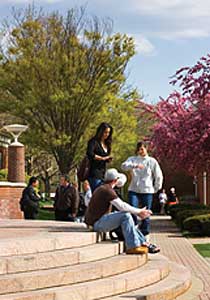
O&G Industries, based in Torrington, CT, is showcasing and fabricating Stony Creek Classic granite locally and has just completed a large fabrication and installation for the Quinnipiac University York Hill Campus Dormitories, designed by Centerbrook Architects and Planners, LLP.
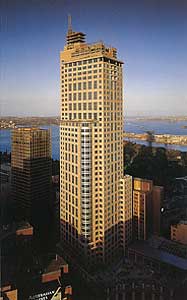
Stony Creek Classic granite has also made its mark overseas, being used on projects such as the Chiefly Tower in Syndney, Australia, designed by Kohn Pedersen Fox Associates.

Skidmore, Owings & Merrill LLP specified Stony Creek Classic granite for the Islamic Cultural Center in New York.
